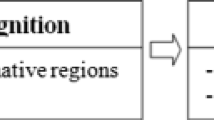Abstract
Machine understanding of human interactive behaviour is a challenging task. In this paper, facial expressions are used to induce emotions on a group of subjects and sense fuzzy human interactive behaviour. When fuzzy quantification theory II is used to analyze the emotions induced by facial expressions, the relationship between induced emotions and facial features is linearized by solving a dense generalized eigenvalue problem. As the matrices are ill-conditioned and indefinite when small data set of facial expressions is used, the theory describing the possible solutions of the eigenvalue problem gets complicated. This paper proposes a perturbation of the eigenvalue problem by using the Moore–Penrose pseudoinverse that keeps the error bounds of the solution within the error bounds of the widely used GUPTRI algorithm. Experimental results show that GUPTRI algorithm fails in some cases where the number of samples is very small while the solution provided by proposed approach never fails and is more accurate.
Similar content being viewed by others
References
Pantic, M., Bartlett, M.S.: Machine analysis of facial expressions. In: White, D.A., Sofge, D.A. (eds.) Handbook of Intelligent Control: Neural, Fuzzy, and Adaptive Approaches, Chap. 20. I-Tech, Viena (2007)
Kitaoka T., Diago L.A., Hagiwara I.: Definition, detection and generation of Iyashi expressions. JSME J. Comput. Sci. Technol. 2(4), 413–422 (2008)
Diago L.A., Kitaoka T., Hagiwara I.: Development of a system for automatic facial expression analysis. JSME J. Comput. Sci. Technol. 2(4), 401–412 (2008)
Diago, L.A., Kitaoka, T., Hagiwara, I.: Analyzing KANSEI from facial expressions with fuzzy quantification theory II. In: Proceedings of 18th IEEE International Conference on Fuzzy Systems, ICC Jeju, Jeju Island, Korea, 20–24 Aug 2009, pp. 1591–1596 (2009)
Sutherland J.G.: Holographic model of memory, learning and expression. Int. J. Neural Syst. 1, 256–267 (1990)
Sugeno, M.: Theory of Fuzzy Integrals and its Applications, PhD dissertation, Tokyo Institute of Technology, Japan (1974)
Watada, J.: Fuzzy quantification theory. In: Terano, T., Asai, K., Sugeno, M. (eds.) Handbook of Intelligent Control: Neural, Fuzzy, and Adaptive Approaches, Chap. 6, pp. 101–123. Academic Press, Boston (1992)
Stewart, G.W.: Matrix Algorithms. Vol. II: Eigensystems. Society for Industrial and Applied Mathematics, p. 469 (2001)
Kronecker, L.: Algebraische Reduction der Schaaren Bilinearer Formen, pp. 763–766. S.B. Akad. (1890)
Demmel J., Kagstrom B.: The generalized Schur decomposition of an arbitrary pencil: robust software with error bounds and applications. Part I: Theory and algorithms. ACM Trans. Math. Softw. 19(2), 160–174 (1993)
Demmel J., Kagstrom B.: The generalized Schur decomposition of an arbitrary pencil: robust software with error bounds and applications. Part II: Software and applications. ACM Trans. Math. Softw. 19(2), 175–201 (1993)
Lucas, C.: Algorithms for Cholesky and QR Factorizations, and the Semidefinite Generalized Eigenvalue Problem. PhD Dissertation, The University of Manchester, UK (2004)
Courrieu P.: Fast computation of Moore–Penrose inverse matrices. Neural Inf. Process. Lett. Rev. 8(2), 25–29 (2005)
Guyon I., Elisseeff A.: An introduction to variable and feature selection. J. Mach. Learn. Res. 3, 1157–1182 (2003)
Higham D.J., Higham N.J.: Structured backward error and condition of generalized eigenvalue problems. SIAM J. Matrix Anal. Appl. 20(2), 497–512 (1998)
Dolan E.D., More J.J.: Benchmarking optimization software with performance profiles. Math. Program. 91(2), 201–213 (2002)
Wright T.G., Trefethen L.N.: Large-scale computation of pseudospectra using ARPACK and Eigs. SIAM J. Sci. Comp. 23, 591–605 (2001)
Okuhara K., Tanaka T., Sakawa M.: Cultivation environment evaluation and kind selection system for crops using the method II of fuzzy quantification (in Japanese). Trans. IEICE J85-A(8), 887–894 (2002)
Author information
Authors and Affiliations
Corresponding author
About this article
Cite this article
Diago, L.A., Kitaoka, T., Hagiwara, I. et al. Analyzing facial expressions with fuzzy quantification theory II: indefinite generalized eigenvalue problem. Japan J. Indust. Appl. Math. 28, 153–170 (2011). https://doi.org/10.1007/s13160-011-0035-z
Received:
Revised:
Published:
Issue Date:
DOI: https://doi.org/10.1007/s13160-011-0035-z
Keywords
- Fuzzy quantification
- Facial expression analysis
- Ill-conditioned generalized eigenvalue problem
- Small sample dataset




